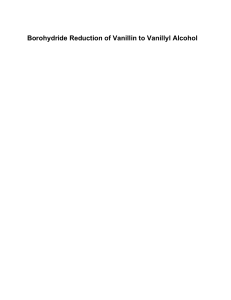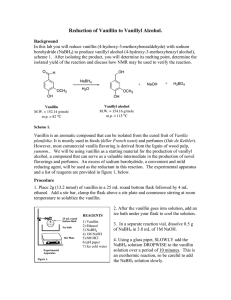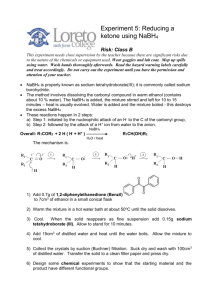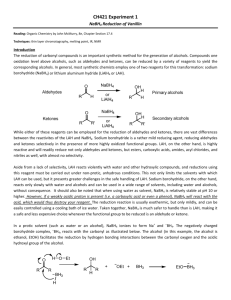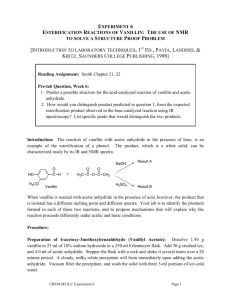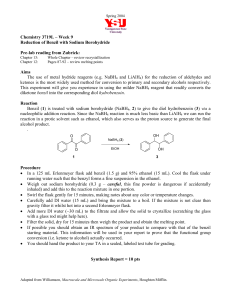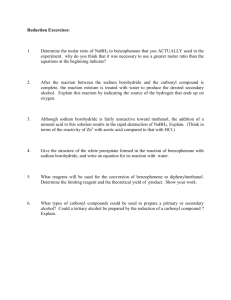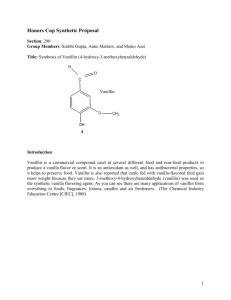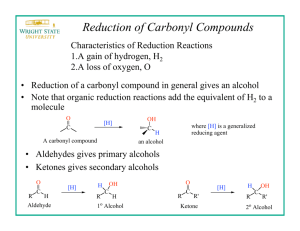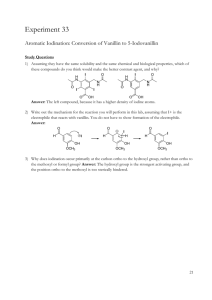12BL Experiment 7: Vanillin Reduction Safety
advertisement
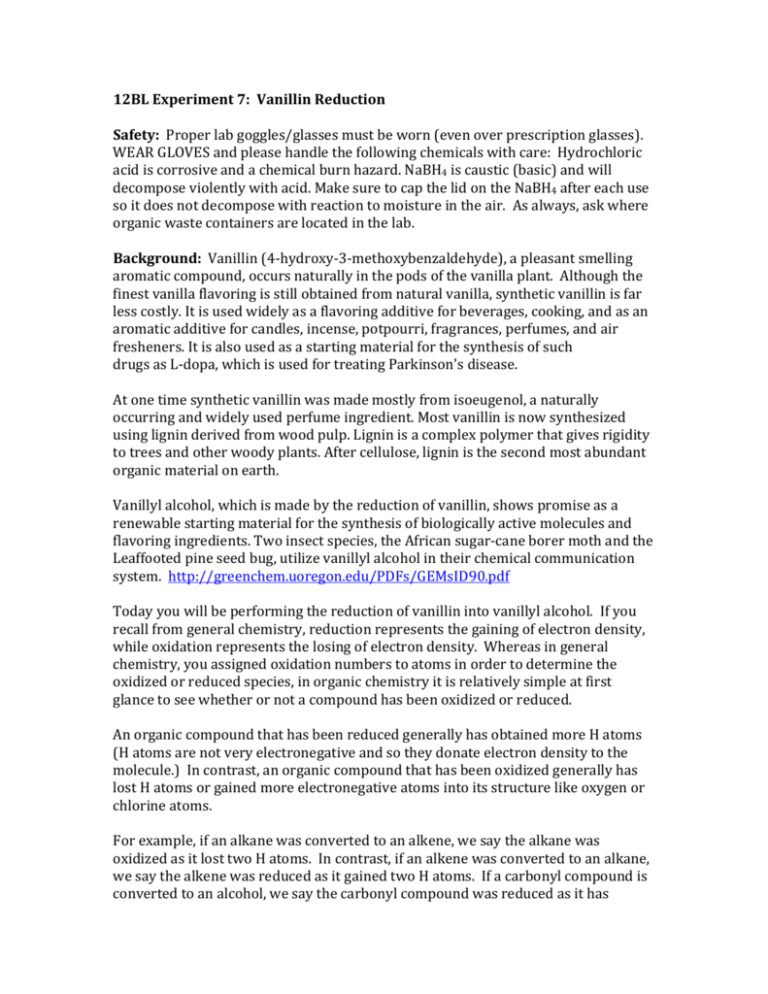
12BL Experiment 7: Vanillin Reduction Safety: Proper lab goggles/glasses must be worn (even over prescription glasses). WEAR GLOVES and please handle the following chemicals with care: Hydrochloric acid is corrosive and a chemical burn hazard. NaBH4 is caustic (basic) and will decompose violently with acid. Make sure to cap the lid on the NaBH4 after each use so it does not decompose with reaction to moisture in the air. As always, ask where organic waste containers are located in the lab. Background: Vanillin (4-­‐hydroxy-­‐3-­‐methoxybenzaldehyde), a pleasant smelling aromatic compound, occurs naturally in the pods of the vanilla plant. Although the finest vanilla flavoring is still obtained from natural vanilla, synthetic vanillin is far less costly. It is used widely as a flavoring additive for beverages, cooking, and as an aromatic additive for candles, incense, potpourri, fragrances, perfumes, and air fresheners. It is also used as a starting material for the synthesis of such drugs as L-­‐dopa, which is used for treating Parkinson's disease. At one time synthetic vanillin was made mostly from isoeugenol, a naturally occurring and widely used perfume ingredient. Most vanillin is now synthesized using lignin derived from wood pulp. Lignin is a complex polymer that gives rigidity to trees and other woody plants. After cellulose, lignin is the second most abundant organic material on earth. Vanillyl alcohol, which is made by the reduction of vanillin, shows promise as a renewable starting material for the synthesis of biologically active molecules and flavoring ingredients. Two insect species, the African sugar-­‐cane borer moth and the Leaffooted pine seed bug, utilize vanillyl alcohol in their chemical communication system. http://greenchem.uoregon.edu/PDFs/GEMsID90.pdf Today you will be performing the reduction of vanillin into vanillyl alcohol. If you recall from general chemistry, reduction represents the gaining of electron density, while oxidation represents the losing of electron density. Whereas in general chemistry, you assigned oxidation numbers to atoms in order to determine the oxidized or reduced species, in organic chemistry it is relatively simple at first glance to see whether or not a compound has been oxidized or reduced. An organic compound that has been reduced generally has obtained more H atoms (H atoms are not very electronegative and so they donate electron density to the molecule.) In contrast, an organic compound that has been oxidized generally has lost H atoms or gained more electronegative atoms into its structure like oxygen or chlorine atoms. For example, if an alkane was converted to an alkene, we say the alkane was oxidized as it lost two H atoms. In contrast, if an alkene was converted to an alkane, we say the alkene was reduced as it gained two H atoms. If a carbonyl compound is converted to an alcohol, we say the carbonyl compound was reduced as it has gained two H atoms. There are many examples and you should familiarize yourself with recognizing whether an organic reaction is undergoing oxidation or reduction. Common reducing agents in organic chemistry are the powerful lithium aluminum hydride and the more mild sodium borohydride. Both contain hydride anions (H–), which ultimately can be donated to a molecule thereby reducing it. LiAlH4 reacts violently with protic solvents (like water and alcohols) and therefore is not appropriate for a general organic chemistry lab. However, NaBH4 is mild and can be used in typical lab conditions. However, it is important that the reaction is carried out in a strongly basic environment like NaOH. Since hydride ions will ultimately be in solution from NaBH4, what might the problem be if there were strongly acidic hydrogen protons in solution as well? Our goal is for the hydride anion to attack the carbonyl bond of vanillin ultimately reducing it. The problem is that vanillin contains a more acidic alcohol functional group to start with and the hydride will attack it instead of the weakly acidic carbonyl carbon, ultimately decomposing the hydride in the form of hydrogen gas. Can you show these mechanisms of attack? The presence of a strong base like hydroxide will ensure that hydroxide deprotonates the alcohol functional group and the hydride now has the opportunity to seek out the carbonyl carbon. In addition, the reacting solutions should not exceed 25˚C in order to prevent the NaBH4 from decomposition during reaction; at the end of the reaction period, the solution will be acidified with HCl to decompose excess NaBH4 as well as to protonate all oxide anions, O–, to their reduced OH state. Looking at the mechanisms that occur today, how will an IR explain the purity of your product? What bond is present in vanillin that should now be absent in vanillyl alcohol? What wavenumber is this at? Objective: To successfully reduce vanillin to vanillyl alcohol and to understand the reaction mechanisms occurring throughout the experiment. To perform melting point and IR analysis to ensure purity of vanillyl alcohol. Procedure: 1. Place 1.0 g of vanillin in a 25 mL round bottom flask and add 4.0 mL of ethanol. 2. Add a stir bar and clamp the flask above a stir plate. Begin stirring to dissolve the vanillin. 3. Once all the vanillin has dissolved, add an ice water bath under your flask to cool the solution. 4. In a 10 mL beaker dissolve 0.25 grams of NaBH4 in 1.9 mL of NaOH. Gently swirl to dissolve. *5. Use a plastic pipette to SLOWLY add the NaBH4 solution DROPWISE to the vanillin solution in the flask OVER A PERIOD OF 10 MINUTES! If you add too fast, the reaction will foam over and you must begin again! 6. After the addition of NaBH4 solution is complete, remove the ice bath, while continuing to let the mixture in the flask stir at room temperature for 10 minutes. 7. After 10 minutes of stirring at room temp, replace the ice bath and SLOWLY add 6M HCl DROPWISE until the evolution of hydrogen gas stop (recall you are decomposing the excess NaBH4). 8. Check the pH with pH paper – dip the tip of a glass stirring rod into your mixture and use this to touch the pH paper – never stick the paper into the flask! The pH should be 2 or below. If not, add a few more drops of HCl and recheck the pH. 9. Once you have sufficient acid, continue to stir for 10 more minutes while cooling. The product should begin to precipitate. After 10 minutes, stop the stirring and continue to ice your mixture to further precipitation. This may take awhile! 10. Collect the product by micro filtration. Use ice cold water to rinse your flask and pour over the crystals on the filter; also rinse your crystals with fresh ice cold water to thoroughly clean them. Transfer to a clean beaker to dry. 12. Take the melting point range and IR of your dry product. Adapted from: http://www.udel.edu/chem/CHEM322/Handouts/vanillin_reduction.pdf 12BL Prelab Experiment 7: Vanillin Reduction 1. What is a chemical reduction? 2. Give two Organic examples of Functional Group Reductions NOT FOUND IN THIS LAB: ________________________ -­‐-­‐-­‐reduction-­‐-­‐ _________________________ (functional group) (functional group) ________________________ -­‐-­‐-­‐reduction-­‐-­‐ _________________________ (functional group) (functional group) 3. Give the Lewis Structure of a HYDRIDE. Don’t forget any formal charges. 4. Is a hydride considered an acid or a base? Explain clearly. 5. Briefly and clearly indicate how an IR can be used to distinguish between your reactant vanillin and your product vanillyl alcohol. Be sure to include both molecules in your discussion, including structures and wavenumbers. 12BL Postlab Experiment 7: Vanillin Reduction 1. Attach your completely analyzed IR – all bonds and their wavenumbers should be labeled in appropriate positions; also include structure of product on IR. 2. How much sodium borohydride should use AND why? 3. What type of environment are reductions generally carried out in and why? 4. Does your reactant vanillin have any acidic functional groups? If so, what is it? What does this mean about what solvent you will use? 5. After the reaction is complete, how will you decompose any unreacted sodium borohydride? Show the mechanism for this reaction. 6. Give the organic product for each reaction below. Read your reagents carefully! + NaBH4 + 1. NaOH 2. NaBH4 + 1. NaBH4 2. HCl
